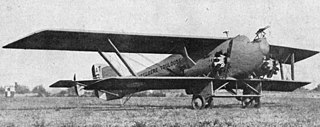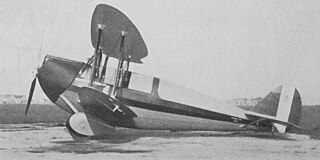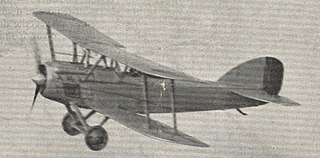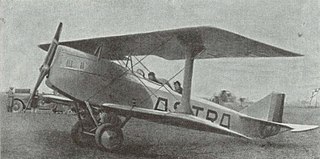Related Research Articles

The de Havilland DH.27 Derby was a large single-engined biplane designed to a heavy day bomber Air Ministry specification. It did not reach production.

The Latécoère 6 was a French four-engined biplane bomber of the early 1920s. It was of advanced all-metal construction and probably the first aircraft to use geodetic construction. Only one was built.

The Caproni Ca.125 was a single-engine, tandem two-seat, touring biplane built in Italy in 1933. It could be operated either as a landplane or seaplane.

The Siemens-Schuckert L.I was a large, three-engined biplane bomber aircraft, built in Germany towards the end of World War I. It was a twin boom design, strongly influenced by the successful Caproni Ca.3. Three were built but not used operationally.

The Potez 40 was a French three-engine, braced high-wing monoplane designed and built in response to a French government programme for colonial transport and policing aircraft duties.

The Heinkel HD 20 was a twin engine, three seat German biplane built in 1926 for civil survey work.

The Astra-Protopopescu or Astra-Proto was a Romanian reconnaissance aircraft flown and tested in 1925.

The Caproni Ca.95 was a large, three engine, long range, heavy bomber prototype built in Italy in 1929. It could carry a 1,600 kg (3,500 lb) bomb load and had three defensive gun positions. Only one was built.
The Leduc RL-12 was a French low power, economical, parasol wing, single seat aircraft. First flown in July 1939, its development was halted by World War II.

The Nieuport-Delage NiD 580 R.2 was a contender for a French government contract for a long range, two seat reconnaissance aircraft, issued in 1928. There were eight prototypes in the 1931-2 contest and the NiD 580 was not selected for production.

The Astra-Șeșefschi was a two-seat Romanian reconnaissance aircraft designed and built in 1923.
The Caproni Ca.61 was an Italian heavy day bomber aircraft of 1922. It was the final development of the Caproni three engine, twin boom biplane types developed during World War I, but it was not put into production.
The Peyret-le Prieur seaplane was a low power, two seat biplane floatplane trainer flown in France in 1924. It did not reach production.
The Potez 24 A.2 was a mid-1920s French biplane intended to replace the Potez 15 as an army observation aircraft. The further improved and larger Potez 25 was preferred for production.
The Blériot 117 or B-117 was a large, twin-engined French aircraft from the mid-1920s. Heavily armed with three gun positions, it was designed to defend bomber formations against fighter attack. It did not reach production but was developed into the more successful Blériot 127.
The CPA 1 was a French twin-engined, parasol-winged bomber designed and built in the mid-1920s.
The Cañete Pirata, also known as Hidro Antonio Cañete de Reconocimiento (HACR), was a Spanish military parasol wing, single-engined flying boat flown in the late 1920s. Only one was built.

The Schneider Henri-Paul was a French four-engined night bomber with an all-metal airframe. A single example was built and flown in 1922.
The Caproni Ca.66 and Caproni Ca.67 were Italian night bomber aircraft designed to re-equip the post-World War I Regia Aeronautica.

The Huff-Daland HD.8A was a small civil transport biplane carrying two passengers built in the U.S. in 1922. The otherwise identical HD-9A offered an alternative engine.